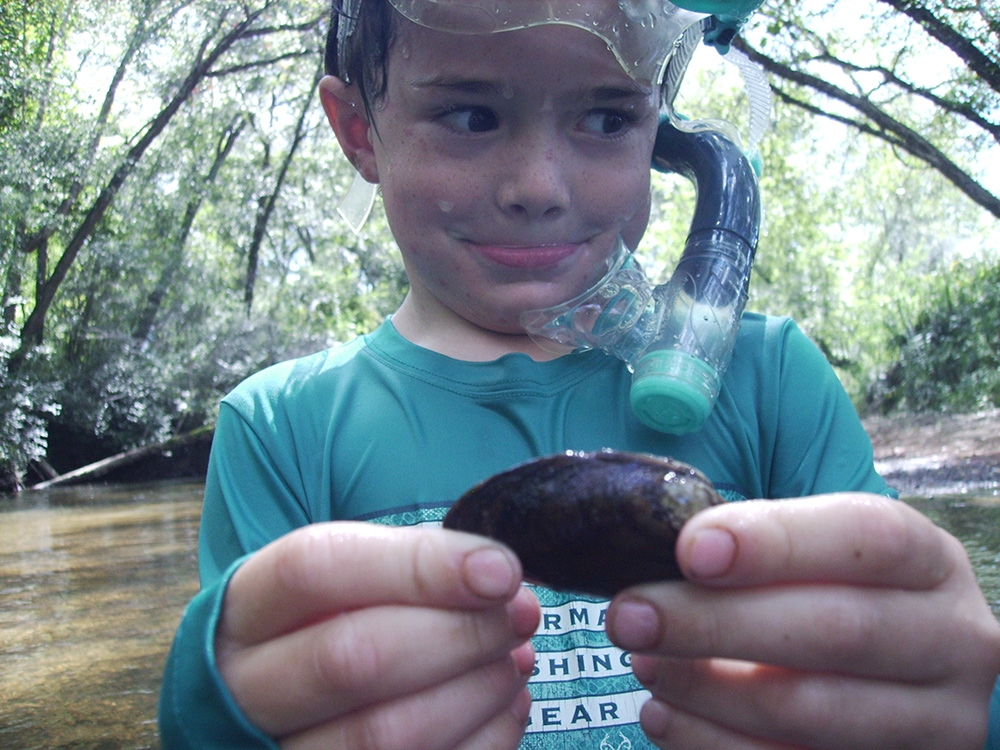The Hidden World Of Rivers
By Torry Nergart, Stewardship Manager at Conserving Carolina.

For us terrestrial creatures, it’s tough to see the living world of the aquatic realm. Most all forms of underwater life have some form of camouflage that prevents us (and say, Ospreys, Eagles) from seeing them from the dry side of things. Consider the Smallmouth Bass, aka the ‘Bronzeback,’ so nicknamed for the disruptive pattern and brown coloration as viewed from above. Aquatic animals get to live their lives relatively free from bother by us land-dwellers, unless we make accommodations like inventing specialized gear to breach the barriers.
For instance, a wetsuit really helps to stay in cold water longer, but not entirely necessary. All you need to catch a glimpse into the aquatic world is a clear cover for your eyes- a snorkel mask, goggles, or just a view bucket. Adding a snorkel extends the adventure unless you’ve managed to grow gills. While viewed from land, our local rivers appear to be just shades of brown. But below the surface is a teem of colors, across all the spectrum. Just the names of some of the fishes found in our rivers hint at all this color: the Greenside Darter, the Saffron Shiner, the Golden Redhorse.
In addition to the bright colors, there is also an outstanding variety of life forms below the surface. Snails, crayfish, mussels, salamanders and insects add to the richness of life underwater. Each one fulfills important roles in the ecosystem. Crayfish shred organic matter and scavenge, snails scour the river rocks for algae to eat. In an interesting twist, one of the most unassuming creatures does one of the most magnanimous service- the freshwater mussel filters and cleans the water that all us living things rely on.

Freshwater mussels were once found is most all waterways here in the mountains. Now their habitat has been greatly reduced due to many factors, starting with our most common water pollutant: sedimentation. As we scrape away at the land with excavating machines, rain carries the erosion into our waterways, covering life there in unbreathable silt. Things that can’t easily run away and relocate, like a mussel, are buried alive. Add to it the channelization of waters (dikes, ditches, drain tiles) then even the sediment doesn’t have much place to go. This disconnection from the floodplain and the elimination of its wetlands means no home for underwater living things.
Hence the need to restore the connection of the river to its floodplain. A river can be thought of as a living thing on its own, always moving in and out of wetlands, braiding its channel through rocky islands of Sycamore trees, creating oxbow lakes as it retreats from old channels. See John McPhee’s ‘The Control of Nature’ on the folly and losing fight against water- we land dwellers still haven’t figured out that when encountered with the uncontrollable, we should consider adapting. That adaptation should be let the river be alive- re-create connection to wetlands that can absorb floodwaters, re-create backwaters that can home all the living creatures that make rivers function.
So with the last bit of Summer we have left (I’m not letting go until September 23rd, the Autumnal Equinox!) consider giving river snorkeling a try. Starting at Champion Park in Rosman is a great place, or brave the chill of the Davidson in Pisgah National Forest. As the headwaters of the French Broad and most all of the Davidson River have protected watersheds, the viewing is still quite good compared to other downstream waterways. Finding the hidden treasures of underwater life may get you to think on how we treat our waters, and might even inspire you to protect them. If you discover this joy, and understand the threats to it, support the work of Conserving Carolina and other organizations that protect our rivers.
Conserving Carolina has had successes with major river restorations at Mud Creek, in Etowah, further up at Pleasant Grove, and upstream on the East Fork. Many more are being planned. My measure of these restoration successes are how fast freshwater animals, insects, amphibians, birds, and so many walks of Life flock to them. Frogs will lay eggs in the erosion control matting, tracked Muskie fish pinged a tracking station within days, birds began nesting above these new hunting grounds. Rebuilding the river’s connection to its floodplain can help us rebuild our own connection to the living world.